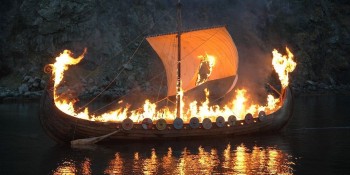Today is Memorial Day in the United States, the day that marks the unofficial start of summer, and the day we honor and remember those who died in military service to the country.
We live in a relatively peaceful time here in the States. While I know a few soldiers or veterans from my generation, I haven’t personally known anyone who died in the Iraq or Afghanistan wars. Of course, over 6,700 have given their lives in these and other recent military engagements since the year 2000, but the days when U.S. soldiers would come back in body bags by the thousands seem to be mostly behind us, as our technology continues to outpace that of the third-world militias against which we tend to fight, and as machines take over much of the riskier jobs.
The good news, of course, is that we have fewer service men and women to mourn. The only trouble is that, because of our lack of practice, we’ve collectively grown worse at mourning and honoring those who have died for us in the past, and those who continue to die for us in the present. We do have a lot of great Memorial Day sales, though, right? So that’s something.
Memorial Day as we know it came out of the American Civil War. While the true origin is a point of some contention, ranging from observances held in Waterloo, New York, to Boalsburg, Pennsylvania, to Warrenton, Virginia, to Savannah, Georgia, there came about a common practice between 1861 and 1864 of decorating the graves of soldiers with flowers. Of course, graves have been decorated with flowers before that, but the establishment of a broad tradition of so adorning the graves of soldiers, specifically, began in response to the Civil War’s massive casualties, which reached somewhere around 600,000 to 700,000 by the end.
In fact, the holiday was called “Decoration Day” until 1967, shortly before the passage of the “Uniform Monday Holiday Act.” That law designated it, along with Columbus Day, Veterans Day, and Washington’s Birthday (now more commonly called Presidents Day) to always fall on Mondays in order to create convenient three-day weekends. Prior to that, Memorial Day occurred May 30 every year.
So, we have parades and grave decoration and flags flying at half-staff, but the day is no longer called Decoration Day, but Memorial Day. What’s the best way to go about remembering? The word “memory” is closely linked with the word “mind.” They share common roots, such as Greek merimna (“care, thought”), Latin memini (“remembrance”), and Old English murnan (“mourn, remember sorrowfully”).
The Norse giant Mímir (“rememberer, wise one”) had his head cut off in the Æsir-Vanir War, and the god Odin carried Mímir’s head around with him, apparently in order to hear the dead, beheaded giant speak secret knowledge to him. A similar word is “mnemonic,” which comes from Greek mnemonos (“mindful, remembering”). The goddess Mnemosyne birthed the nine Muses and presided over a pool in the underworld, granting memories back to those who had drunk from the river Lethe and forgotten their past lives.
So we remember our fallen soldiers by visiting their graves and decorating them with flowers. We symbolically give them life for a day out of the year. What have other cultures done to honor and remember their dead?
The Aztecs didn’t bury their dead at all, but burned them, as offering to the sun god. The dead (and the soon-to-be-dead via sacrificial knife wound) would be dressed in ceremonial garb and burned at the holy ziggurat. This also had the side effect of limiting the spread of disease. When warriors died afield, their bodies were burned en masse after the battle, and one of their arrows was returned home … to be dressed in ceremonial garb and burned in their stead.
In the time of Vikings, Scandinavians were often sent off in a small funeral boat with some of their treasured possessions. The boat would then be lit on fire, again to limit the spread of disease. A dead warrior’s soul was said to be escorted to Valhalla by the valkyrie (“chooser of the slain”), warlike maidens who may or may not be Odin’s daughters. The warriors then became einherjar (“fighters for a single time”), who eat of a beast that resurrects each night and train to fight in Ragnarök (“conjured fate”), the final battle that will destroy the world and create it anew.
Egyptians buried their dead rather than lighting them on fire. Rich Egyptians might afford mummification, including all the necessary preparations and spells (like pulling liquid brains out of the nose with a hook) that would make it most likely the person’s spirit would be welcomed into the afterlife by the gods. Common foot soldiers likely would have been put along with some of their best possessions into a pit, where the heat and dryness would preserve the body to some degree. That way, their ba and ka (sort of like their mind and their agency) might unite and become ahk, which is sort of a benevolent ghost energy, ideally watching over and protecting their living loved ones.
Maybe this Memorial Day, you don’t know any soldiers who’ve given their lives in service. If you do, though, you might try branching out in how you remember them. Decorate their graves with flowers, sure, but how about burning one of their arrows, cheering them on in their Ragnarök training, or saluting their ahk, which may be floating around you as you’re reading this?
Probably just stick with the flower thing.
